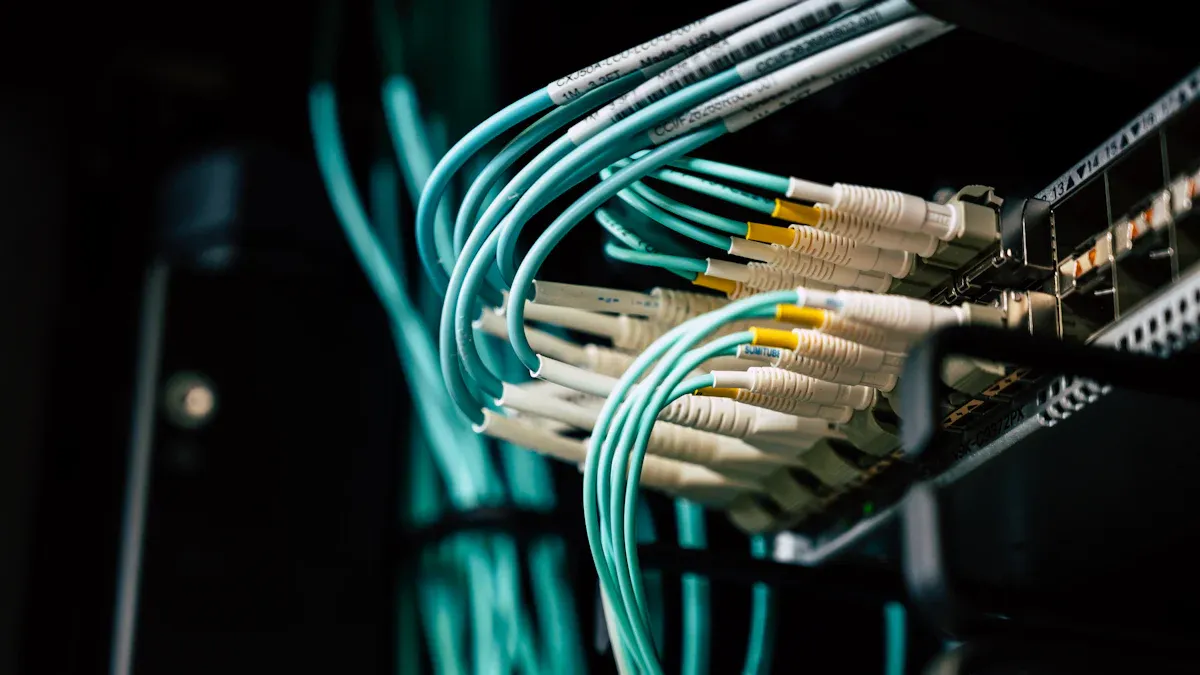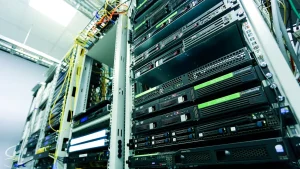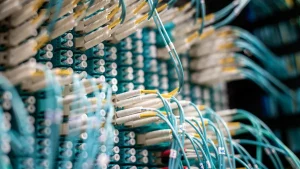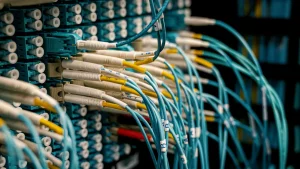
A Protocol Data Unit (PDU) represents the fundamental unit of data exchanged between layers of a network protocol stack. This structured block of information carries both control data and user data, enabling seamless communication. Network devices process these data units to ensure information reaches its intended destination. For instance, a 40G QSFP+ LR4 10km transceiver for SMF handles these data units at high speeds. Understanding this concept is crucial for grasping network operations. Even in power distribution, a 19″ PDU Indian style provides essential infrastructure, showcasing the term’s importance in various contexts.
Key Takeaways
- A Protocol Data Unit (PDU) is a basic unit of data. It moves between network layers.
- Each network layer has its own PDU type. Examples include bits, frames, packets, and segments.
- Encapsulation adds information to data. This happens as data moves down network layers.
- Decapsulation removes information from data. This happens as data moves up network layers.
- PDU headers contain important control details. These include source and destination addresses.
- PDUs help find errors in data. They also ensure data arrives in the correct order.
- PDU size affects network speed. Large PDUs can be broken into smaller pieces.
- PDUs are vital for all network communication. They help different devices talk to each other.
1. Understanding the Essence of a PDU
What is a PDU?
Data Units in Networking
A Protocol Data Unit (PDU) represents the fundamental unit of data exchanged between communicating entities. These entities adhere to a specific networking protocol. Network professionals find these units crucial when working with multilayer protocol stacks and managing protocol interactions. Networking protocols, especially those developed within layered reference models like the OSI or TCP/IP models, define their own units of data exchange. For instance, an IP packet serves as the PDU for the Internet Protocol, facilitating interactions between hosts identified by IP addresses at the network layer.
The Role of Protocols in PDU Formation
Protocols dictate the structure and content of each PDU. They ensure all network devices interpret the data correctly. A PDU typically consists of three main parts:
- Protocol header: This sequence of fields contains specific data about the PDU. It often includes destination and source addresses. Headers can be fixed or variable in length, depending on the protocol.
- Payload: Also known as the protocol body, this is the actual information the protocol transmits.
- Protocol trailer: A sequence of bits appended to the PDU after the payload. Data link layer protocols commonly use trailers. For example, Ethernet uses a four-octet, 32-bit field containing a cyclic redundancy check value as its trailer.
PDU as a Data Container
PDU Encapsulation Process
A Protocol Data Unit acts as a data container during encapsulation. This methodical transformation occurs at each network layer. During encapsulation, a lower protocol layer treats the Service Data Unit (SDU) from the higher layer as its payload. To perform its function, the lower layer adds specific data. This includes a port number, network address, data type identifier, and error-checking information, to the SDU. This combination of the original SDU and the added control information constitutes the PDU at that particular layer. It effectively makes the PDU a container for both the original data and the layer’s operational details. This process involves:
- Application Data: The original data originates from the application.
- Transport Layer: It adds a TCP/UDP header to the application data, forming a Segment/Datagram (Transport PDU).
- Network Layer: It adds an IP header to the Segment/Datagram, creating a Packet (Network PDU).
- Data Link Layer: It adds an Ethernet/Wi-Fi header and trailer to the Packet, forming a Frame (Data Link PDU).
- Physical Layer: It converts the frame into bits (Physical PDU) for transmission.
Each layer adds its own control information (headers and sometimes trailers) to the data received from the layer above. This ensures the corresponding layer on the receiving end can correctly handle the data. This wrapping of data with layer-specific information allows each layer to perform its function independently.
PDU Decapsulation Process
Decapsulation is the reverse of encapsulation. As the PDU travels up the protocol stack on the receiving device, each layer removes its specific header and trailer. It then passes the remaining data to the layer above. This process continues until the application layer receives the original data. This ensures the application can process the information as intended.
2. PDUs Across the OSI Model Layers
The Open Systems Interconnection (OSI) model provides a conceptual framework for understanding network communication. Each layer within this model handles data in a specific format, known as its Protocol Data Unit. These PDUs change form as data moves through the layers.
Physical Layer PDU: Bits
Bits as the PDU
At the physical layer, the lowest layer of the OSI model, the Protocol Data Unit is simply a bit. A bit represents the most basic unit of information in computing, a binary digit (0 or 1). This layer concerns itself with the physical transmission of raw bit streams over a communication medium. It does not interpret the meaning of these bits; it only transmits them.
Electrical Signals and PDU Transmission
The physical layer translates these bits into electrical, optical, or radio signals. These signals travel across the network medium, such as copper cables, fiber optics, or wireless airwaves. For example, a voltage change on an Ethernet cable might represent a ‘1’, while no voltage represents a ‘0’. The physical layer ensures the reliable transmission of these raw signals from one device to another.
Data Link Layer PDU: Frames
Understanding PDU Frames
The data link layer takes the raw bits from the physical layer and organizes them into frames. A frame serves as the Protocol Data Unit at this layer. Frames add structure to the bit stream, allowing for error detection and flow control within a local network segment.
Key components of a frame include:
- Header: This contains source and destination MAC addresses, frame type, and control fields.
- Payload: This carries the actual data from higher layers.
- Trailer: This includes the Frame Check Sequence (FCS) for error detection.
- Start and End Delimiters: Specific bit patterns mark the beginning and end of a frame. These delimiters help receiving devices identify frame boundaries.
The header and trailer define the distinct beginning and end of data frames. This allows receivers to identify frame boundaries and distinguish between different frames. Specific syntax and structure enable the data receiver to identify where a frame starts and ends.
MAC Addresses and PDU Addressing
Frames use Media Access Control (MAC) addresses for addressing within a local network. Each network interface card (NIC) has a unique MAC address. The data link layer uses these addresses to ensure frames reach the correct device on the local segment.
Network Layer PDU: Packets
Defining PDU Packets
At the network layer (Layer 3), the Protocol Data Unit is referred to as a ‘packet’. These packets encapsulate data intended for transmission and include header and footer information. For instance, the IPv4 protocol adds an IPv4 header containing crucial details like the source address, destination address, protocol type, and time-to-live (TTL), which are essential for delivery. If a packet’s size exceeds the Maximum Transmission Unit (MTU) of a network segment, the network layer fragments the packet into smaller pieces. It then adds headers to each fragment for identification and sequencing. It reassembles the fragments into the original packet at the destination, ensuring data integrity across networks with varying capabilities.
IP Addressing for PDU Routing
Routers utilize routing tables to make forwarding decisions for packets. These tables store information about various paths to different networks. Forwarding decisions are based on the destination IP address found within the packet header, ensuring packets move efficiently towards their intended destination. Routing is the process at the network layer that involves moving packets from one device to another. The network layer employs strategies to identify the optimal route among multiple available paths from the source to the destination. Various routing protocols facilitate coordination among routers, enabling them to establish communication across the network.
Transport Layer PDU: Segments and Datagrams
PDU Segments and Datagrams
The transport layer, sitting above the network layer, handles end-to-end communication between applications. At this layer, the Protocol Data Unit takes two primary forms: segments for TCP (Transmission Control Protocol) and datagrams for UDP (User Datagram Protocol). TCP segments provide reliable, connection-oriented communication, ensuring data delivery, sequencing, and error checking. UDP datagrams, conversely, offer a connectionless and faster service, prioritizing speed over guaranteed delivery. Both segments and datagrams encapsulate data from the upper layers and add their respective headers, which contain information vital for their specific functions.
Port Numbers for PDU Delivery
Port numbers play a crucial role in the transport layer’s function. They identify specific applications or services running on a host. When a segment or datagram arrives at a destination device, the transport layer uses the port number in its header to direct the data to the correct application. For example, web traffic typically uses port 80 (HTTP) or 443 (HTTPS), while email might use port 25 (SMTP). This mechanism allows multiple applications on a single device to communicate over the network simultaneously without data getting misdirected.
Upper Layers PDU: Data
Data as the PDU
At the upper layers of the OSI model—the session, presentation, and application layers—the Protocol Data Unit is simply referred to as data. These layers focus on application-specific functions rather than network transmission details. They handle the actual content that users interact with. The term "data" at these layers signifies the raw information or processed content that applications generate, format, or manage.
Application Data in PDU
The structure of application data as a pdu at the upper layers involves a progression of processing:
- Application Layer: Applications create the data. This is the layer where user interaction originates, generating the initial information for transmission.
- Presentation Layer: Data is formatted and encrypted. This layer ensures that data is presented in a format understandable by the receiving application, handling tasks like data compression and encryption.
- Session Layer: Connections are established and managed. This layer controls the dialogues between applications, setting up, managing, and terminating communication sessions.
The following table summarizes the PDU at these upper layers:
| Layer | Protocol Data Unit |
|---|---|
| Application Layer | Data |
| Presentation Layer | Data |
| Session Layer | Data |
These layers work together to prepare the application’s information for lower-layer transmission and to deliver received information to the correct application in an understandable format.
3. PDUs in the TCP/IP Model
The TCP/IP model, a foundational framework for internet communication, also defines specific Protocol Data Units (PDUs) at each of its layers. This model simplifies the OSI model into four distinct layers, each with its own responsibilities and data formats.
Network Access Layer PDU
Frames and Bits as PDU
The Network Access Layer of the TCP/IP model combines the functionalities of the OSI model’s physical and data link layers. At this crucial layer, data takes two primary forms. At the Data Link sublayer, data exists as frames. These frames encapsulate network layer packets and add MAC addresses for local delivery. Subsequently, at the Physical sublayer, data exists as bits. These bits represent the raw binary data transmitted over the physical medium. This layer prepares data for physical transmission and handles the reception of raw data.
Hardware Addressing for PDU
Hardware addressing is fundamental at the Network Access Layer. Devices use Media Access Control (MAC) addresses to identify each other within a local network segment. Each network interface card (NIC) possesses a unique MAC address. This address ensures that frames reach the correct destination device on the local network. The Network Access Layer manages access to the physical network medium, preventing collisions and ensuring orderly data flow.
Internet Layer PDU
IP Datagrams as PDU
The Internet Layer, also known as the network or IP layer, is responsible for accepting and delivering packets across the network. The Internet Protocol (IP) serves as the primary protocol at this layer. The main Protocol Data Unit at this layer is known as a datagram. IP addressing defines conventions for addressing systems, including both IPv4 and IPv6. It also determines the route a packet takes to reach its destination based on the receiving system’s IP address. The Internet Layer assembles packets into units called datagrams. It also handles fragmentation, breaking down large packets into smaller fragments if necessary, and reconstructs them at the receiving end.
Routing Information in PDU
The Internet layer sends packets across multiple networks to their final destinations. The Internet Protocol (IP) defines IP addresses to route data packets across the Internet. Routers at this layer use the destination IP address within the datagram header to make forwarding decisions. They consult routing tables to determine the most efficient path for the datagram to reach its intended recipient. This process ensures global connectivity and efficient data delivery across diverse networks.
Transport Layer PDU
TCP Segments as PDU
The Transport Layer in the TCP/IP model provides end-to-end communication services for applications. For reliable, connection-oriented communication, the Protocol Data Unit is a TCP segment. TCP segments ensure data delivery, sequencing, and error checking. They establish a connection, transmit data, and then terminate the connection. This reliability makes TCP suitable for applications like web browsing and email.
UDP Datagrams as PDU
Conversely, for connectionless and faster communication, the Protocol Data Unit is a UDP datagram. UDP datagrams prioritize speed over guaranteed delivery. They do not establish a connection or guarantee delivery. This makes UDP ideal for applications where speed is critical and some data loss is acceptable, such as streaming video, online gaming, and DNS lookups.
Application Layer PDU
Application Data Units as PDU
At the Application Layer, the highest layer in the TCP/IP model, the Protocol Data Unit is simply data. This layer directly interacts with software applications. It provides network services to end-user applications. Users generate this data through their interactions with applications like web browsers, email clients, or file transfer programs. The Application Layer prepares this data for transmission across the network. It also receives data from the lower layers and presents it to the appropriate application. This "data" represents the actual information users wish to send or receive. It does not contain any network-specific headers or trailers from the lower layers.
Protocol-Specific PDU Data
While the general term for the PDU at the Application Layer is "data," specific application protocols define their own unique PDU formats. These formats dictate how applications structure their messages. For example, the Hypertext Transfer Protocol (HTTP) uses requests and responses as its PDUs. A web browser sends an HTTP GET request to a web server. The server then sends an HTTP response containing the requested web page. Similarly, the File Transfer Protocol (FTP) defines commands and replies for file transfers. The Simple Mail Transfer Protocol (SMTP) uses specific commands and data structures for sending emails. Each application protocol has its own set of rules for formatting the data it exchanges. These rules ensure that the communicating applications understand each other. This layer handles the details of application-to-application communication. It allows diverse applications to interact seamlessly over the network.
4. The Structure of a PDU
Every Protocol Data Unit (PDU) follows a specific structure, which allows network devices to process and understand the data it carries. This structure typically includes a header, a payload, and sometimes a trailer. Each part serves a distinct purpose in ensuring efficient and reliable data transmission across a network.
PDU Header Components
The header is the first part of a PDU. It contains vital control information that guides the data through the network.
Control Information in PDU Header
PDU headers contain control information such as the PDU type, its length, and various flags. These fields help devices interpret the data correctly. For instance, a version field often appears at the beginning of the header, like in an IP header, to determine the format of subsequent bytes. Headers also include ordinal types, such as 32-bit words for source IP addresses, 16-bit half-words for checksums, or 8-bit bytes for time-to-live values. Some headers also feature bit-fields, which are fields with sizes not a multiple of eight bits, such as the version and flags in IPv4.
Source and Destination in PDU Header
Crucially, the header also specifies the source and destination addresses. These addresses tell the network where the data originated and where it needs to go. Depending on the network layer, these could be MAC addresses for local network communication or IP addresses for routing across the internet.
PDU Payload Content
The payload section of a PDU carries the actual data being transmitted. This is the core information that the sender wants to deliver to the receiver.
Actual Data in PDU Payload
The payload contains the transmitted data sent by communicating endpoints. This can include commands issued by an end user, such as a request for web content. It also carries data transmitted by a server in response to a user request. Essentially, the payload holds the data a user or device wants to send within an IP packet or any other PDU.
Encapsulated PDU within Payload
Often, a PDU’s payload is another PDU from a higher layer. This process, known as encapsulation, allows different network layers to add their own control information while preserving the original data. For example, an IP packet’s payload might contain a TCP segment, which in turn carries application data.
PDU Trailer Elements
Not all PDUs include a trailer, but when present, it typically appears at the end of the data unit. Trailers primarily serve for error detection.
Error Checking in PDU Trailer
Trailers often include an error-detection mechanism. This safeguards against transmission errors, allowing for prompt identification and rectification of issues. Some trailers also include padding bytes if necessary, providing a fixed length for the PDU and marking the end of an LLC PDU.
Frame Check Sequence in PDU
A common element in a trailer is the Frame Check Sequence (FCS). The FCS is a mathematical calculation performed on the PDU’s data. The receiving device performs the same calculation. If the results match, the data arrived without corruption. If they do not match, the receiver knows an error occurred during transmission.
5. PDU Encapsulation and Decapsulation Process

Network communication relies on two fundamental processes: encapsulation and decapsulation. These processes ensure data travels correctly across different network layers and arrives intact at its destination. Encapsulation prepares data for transmission, while decapsulation unpacks it upon arrival.
PDU Data Flow Down the Stack
Data begins its journey at the application layer and moves downwards through the network stack. Each layer performs specific functions, adding its own control information.
Adding Headers to PDU
When data moves down the protocol stack, each layer takes the Protocol Data Unit (PDU) from the layer above and adds its own header information. This process begins at the Application Layer. A user initiates communication, and the application protocol formats the packet for handling by the appropriate transport layer protocol. At the Transport Layer, data encapsulation begins. TCP divides application data into segments and attaches a header. This header contains sender/recipient ports, segment ordering, and a checksum for error detection.
Layer-by-Layer PDU Wrapping
The encapsulation process involves a systematic wrapping of data at each layer.
- Application Layer: A user application generates data for transmission.
- Transport Layer: It adds either a TCP or UDP header. This header includes port numbers, sequence numbers, and acknowledgment numbers for TCP, or source/destination ports, length, and checksum for UDP.
- Network Layer: This layer encapsulates the transport segment within an IP header. The IP header contains source/destination IP addresses, Time to Live (TTL) values, and protocol identifiers.
- Data Link Layer: It creates a frame by adding both a header (with source/destination MAC addresses) and a trailer (with a Frame Check Sequence for error detection).
- Physical Layer: This layer converts the complete frame into electrical signals, light pulses, or radio waves for transmission.
This table summarizes the PDU terminology at each stage:
| Network Layer | PDU Terminology |
|---|---|
| Application Layer | Data or Message |
| Transport Layer | Segment (TCP) or Datagram (UDP) |
| Network Layer | Packet |
| Data Link Layer | Frame |
| Physical Layer | Bits |
PDU Data Flow Up the Stack
Decapsulation is the exact reverse process of encapsulation. It involves the removal of additional information (headers and trailers) that was added on the sender’s side during encapsulation. Data travels from the Physical layer up to the Application layer on the receiver’s side.
Removing PDU Headers
As data ascends the network stack on the receiving device, each layer removes the header and trailer added by its corresponding layer on the sending side. This stripping process reveals the data intended for the next higher layer.
Unwrapping PDU Data
The unwrapping of data occurs in a precise, layer-by-layer sequence:
- Physical Layer: The Network Interface Card (NIC) converts electrical signals into digital data. It performs initial frame validation upon packet arrival.
- Data Link Layer: The NIC or device driver examines the frame header. It checks the destination MAC address. If it matches, it removes the Data Link header, passing the remaining packet to the Network layer.
- Network Layer: The operating system’s network stack examines the IP header. It verifies the destination IP address and extracts routing information. After validation, the IP header is removed, and the appropriate Transport layer protocol is determined.
- Transport Layer: Processing varies by protocol. For TCP, sequence numbers, acknowledgment numbers, and window sizes are examined before removing the TCP header. For UDP, basic header validation occurs before removal.
- Session, Presentation, and Application Layers: These layers handle protocol-specific processing. This may include encryption/decryption, data compression, or format conversion. Finally, they deliver the payload to the destination application.
6. Why PDUs are Crucial for Network Communication
Protocol Data Units (PDUs) are fundamental to networking, ensuring efficient and error-free communication between devices. They serve as the structured containers for data, making them indispensable for modern networks.
Ensuring PDU Data Integrity
PDUs are fundamental for maintaining data integrity during network transmission. They incorporate mechanisms to detect and often correct errors.
Error Detection in PDU
Error detection is a critical function of PDUs. UDP headers include a checksum field. This checksum enables error checking for both the header and the data stream. Similarly, TCP segments also contain a checksum field. This field provides additional reliability and security to the TCP segment, allowing for the detection of errors during transmission.
Reliable PDU Transmission
Reliable transmission ensures data arrives completely and in the correct order. TCP segments use sequence numbers and acknowledgment numbers. These fields are crucial for segment differentiation, reordering, and retransmitting lost segments. They ensure data arrives in the correct order and no data is missing. This table highlights the reliability differences:
| Feature | TCP | UDP |
|---|---|---|
| Reliability | Reliable | Unreliable |
| Segment Retransmission | Yes | No |
| Segment Sequencing | Yes | No |
| Acknowledgment | Yes | No |
Facilitating PDU Network Routing
PDUs play a vital role in guiding data through complex networks. They contain the necessary information for efficient routing.
Addressing Information in PDU
PDU headers serve as data guides. They contain routing details like source and destination addresses. This information directs data to its correct location. Without headers, data would lack direction and could be lost in the network. Sequencing information within the header ensures fragmented data reassembles correctly at its destination.
PDU Path Determination
At the network layer, PDUs are known as packets. These packets incorporate routing information to facilitate smooth and efficient data flow across the network. These packets are crucial for guiding data to its intended destination. The network layer utilizes logical addressing to determine the most effective path for data delivery. Each PDU component, from header to trailer, is crucial for maintaining data integrity and ensuring proper delivery.
Enabling Device Interoperability with PDU
PDUs enable diverse network devices to communicate effectively. They achieve this through standardized formats and protocol adherence.
Standardized PDU Formats
Standardized PDU formats allow different hardware and software to understand each other. This standardization ensures that a frame created by one vendor’s network card can be correctly interpreted by another. This consistency is essential for global network communication.
Protocol Adherence for PDU
Adherence to established protocols is paramount for interoperability. Protocols define the rules for PDU creation and interpretation. This ensures seamless interaction across OSI model layers. For instance, transport layer segments include acknowledgments for delivery confirmation, while network layer packets carry routing data to direct information. This adherence allows devices from various manufacturers to communicate without issues.
7. PDU Fragmentation and Reassembly

Network communication often involves transmitting data across diverse network segments. These segments can have varying capacities. PDU fragmentation and reassembly are crucial processes that manage data transmission efficiently under these conditions.
Breaking Down Large PDU Data
Sometimes, a large Protocol Data Unit (PDU) cannot traverse a network segment in its original size. This necessitates breaking it down into smaller pieces.
MTU Limitations for PDU
IP fragmentation is an Internet Protocol (IP) process. It breaks packets into smaller pieces, called fragments. This allows fragments to pass through links with a smaller Maximum Transmission Unit (MTU) than the original packet size. Networks often have different MTU limits. For example, a packet may need to route across networks (like a WAN or VPN tunnel) with a smaller MTU than the initial transmission network. If a packet’s size exceeds this lower MTU, its data must be fragmented. Fragmentation breaks data into new packets (fragments) that are equal to or smaller than the lower MTU.
Network Efficiency with PDU Fragmentation
Fragmentation enhances network efficiency. It allows transport layer protocols to remain unaware of the underlying network architecture. This reduces overheads. Fragmentation enables IP and higher-layer protocols to function across diverse network paths and mediums. They do not need a path discovery protocol. This flexibility ensures data can reach its destination even when network segments have different size constraints.
Reconstructing PDU Data
After fragmentation, the receiving device must reassemble the smaller fragments into the original PDU. This process ensures data integrity and order.
PDU Order and Integrity
PDUs are crucial for managing data fragmentation during transmission. They break down data packets to comply with MTU levels. They ensure the structure and sequence of fragmented data remain maintained for efficient reassembly at the destination. This system minimizes data loss and enhances transmission reliability. It works even for complex data streams across various network environments. PDUs protect data integrity by verifying that data packets are well-formed, properly ordered, and error-free. This often involves checksums or Cyclic Redundancy Checks (CRC) to detect and correct errors during data transfer. When an IP packet exceeds the MTU size, routers fragment it into smaller pieces. Each fragment includes an identifying header segment. This header contains information such as sequence order and reassembly instructions. At the destination, these headers are used to reassemble the fragments into a complete packet.
Handling Lost PDU Fragments
The transport layer, dependent on the network layer’s activities, manages packet fragmentation and reassembly. TCP protocols handle retransmissions to maintain communication. This ensures reliable delivery. If a fragment is lost during transmission, the receiving device detects the missing piece. It then requests retransmission of that specific fragment. This mechanism guarantees that all parts of the data are received and correctly assembled, maintaining the integrity of the original PDU.
8. PDU Size and Network Performance
The size of a Protocol Data Unit significantly influences network performance. Network administrators must carefully consider PDU dimensions to achieve optimal throughput and minimize latency. This balance is crucial for efficient data transmission across various network environments.
Impact of PDU Size
The dimensions of a PDU directly affect how efficiently data travels through a network. Both excessively small and overly large PDUs can introduce performance bottlenecks.
PDU Overhead Considerations
Every PDU carries not only the actual data (payload) but also control information in its headers and, sometimes, trailers. This control information constitutes overhead. A smaller payload relative to the header and trailer means a higher percentage of the PDU is overhead. This reduces the effective data rate. For instance, a small email might travel in a PDU with a header almost as large as the message itself, making the transmission less efficient.
Throughput vs. Latency with PDU
The size of PDUs directly impacts network throughput and latency. Small data packets, also known as Protocol Data Units (PDUs), can lead to frequent fragmentation within a network. This necessitates the transmission of numerous small packets to convey the same amount of data that a single large packet could carry, thereby impacting network throughput. Conversely, very large PDUs might experience higher latency if they encounter network segments with smaller Maximum Transmission Unit (MTU) limits, requiring fragmentation and reassembly.
Optimizing PDU Size
Network designers employ various strategies to optimize PDU size, tailoring it to specific network conditions and application requirements.
Jumbo PDU Frames
Ethernet networks often utilize jumbo frames, which are PDUs larger than the standard 1500-byte MTU, typically up to 9000 bytes. These larger frames reduce the number of PDUs required to transmit a given amount of data. This decreases processing overhead on network devices and can improve throughput, especially in high-bandwidth environments like data centers. However, all devices on a network segment must support jumbo frames for them to function correctly.
Small PDU Packet Issues
While jumbo frames offer benefits, small PDU packets present their own challenges. Research primarily aims to lessen power consumption and alleviate critical network conditions to meet the prerequisites of Body Area Network (BAN) applications, which have specific service requirements such as throughput, vitality efficacy, and delay. Longer packets observe higher data loss in severe network disorders, whereas shorter packets incur greater data overhead. To regulate the trade-off between network dependability and vitality proficiency, numerous methodologies are anticipated to determine the ideal packet measure in BANs, considering metrics like output proficiency and energy effectiveness. Additionally, small packets increase the number of individual transmissions, potentially leading to more contention and collisions in shared media networks.
Optimizing PDU size often involves techniques like data compression and aggregation:
-
Data Compression: This reduces the size of transmitted data using lossless or lossy algorithms to improve bandwidth utilization and reduce transmission times.
- Lossless compression: Preserves all original data, essential for text files, executables, and data requiring perfect reconstruction (e.g., ZIP, GZIP, LZ77).
- Lossy compression: Achieves higher compression ratios by discarding less important information, suitable for multimedia content where minor quality reduction is acceptable (e.g., JPEG, MP3).
The Presentation Layer automatically decompresses received data, making the process transparent to applications. Built-in compression capabilities dynamically select appropriate algorithms based on content type and network conditions, balancing efficiency with processing overhead.
-
Aggregation: This combines multiple smaller PDUs into a single larger PDU.
Strategy Aggregation Layer Error Recovery Overhead Ideal Conditions Disadvantages/Trade-offs A-MSDU (Aggregated MAC Service Data Unit) Higher layer (before MAC header) Entire frame retransmission Significantly reduced (single MAC header) Low-interference, stable environments (e.g., enterprise offices, data centers) Entire frame discarded and retransmitted if any part is corrupted, leading to latency and reduced performance in noisy environments. Max size generally smaller than A-MPDU. A-MPDU (Aggregated MAC Protocol Data Unit) MAC layer (multiple MAC PDUs) Individual frame retransmission (block acknowledgment) Increased (each frame has its own MAC header) Noisy, high-interference environments (e.g., public spaces, urban areas) Higher overhead compared to A-MSDU, potentially slightly higher baseline latency in pristine environments. Hybrid Approach (A-MSDU nested in A-MPDU) Layered aggregation Selective retransmission Optimized (leverages both) Complex, requires careful tuning Increased complexity in implementation, requires careful tuning to ensure compatibility and stability. Improper configuration can lead to increased latency, higher packet loss, or compatibility issues.
These strategies help networks adapt to diverse requirements, from high-speed data centers to energy-constrained wireless sensor networks.
9. Common PDU Examples in Action
Understanding Protocol Data Units (PDUs) becomes clearer when examining their practical application in real-world network protocols. These examples illustrate how different layers handle data.
Ethernet PDU Frames
Data Link Layer PDU Example
At the data link layer, Ethernet frames serve as the primary PDU. An Ethernet frame encapsulates network layer packets. It adds crucial information for local network communication. This includes the source and destination MAC addresses, which identify specific devices on the same local network segment. The frame also contains a type field, indicating the network layer protocol carried within its payload, such as IPv4 or IPv6. A Frame Check Sequence (FCS) at the end of the frame helps detect transmission errors.
Physical PDU Transmission
After the data link layer forms an Ethernet frame, the physical layer takes over. It converts the entire frame into a stream of bits. These bits then transmit as electrical signals over copper cables, light pulses through fiber optics, or radio waves in wireless networks. The physical layer ensures the raw transmission of these bits from one device to another.
IP PDU Packets
Network Layer PDU Example
At the network layer, the PDU is an IP packet. This packet is a self-contained unit of information. It includes data and sufficient details for independent routing across a network. The Internet Protocol (IP) handles routing these packets from their source to their destination. This process involves selecting the optimal path.
Internet PDU Routing
Routers examine the IP header within each packet. This header contains essential control information, including source and destination IP addresses. These addresses guide routers in directing the packet. IP addresses are hierarchical, comprising a network identifier and a host ID. This structure allows routers to efficiently direct packets by examining the network components of the address. Packets may traverse multiple routers before reaching their final destination. Upon arrival, the packet is decapsulated, and its payload (the actual data) delivers to the appropriate application on the receiving device. IP is a connectionless protocol, offering ‘best-effort delivery’ without guarantees of delivery or data recovery; reliability is handled by other layers.
TCP PDU Segments
Transport Layer PDU Example
The transport layer uses TCP segments as its PDU. TCP segments provide reliable, connection-oriented communication between applications. They encapsulate data from the application layer and add a TCP header. This header contains port numbers, sequence numbers, and acknowledgment numbers.
Reliable PDU Connections
TCP ensures reliable data transmission through several mechanisms. It uses ‘positive acknowledgment with re-transmission.’ The receiver sends an acknowledgment for received data. The sender maintains a record of sent packets and a timer. If an acknowledgment is not received before the timer expires, the packet is re-transmitted. This accounts for potential loss or corruption. TCP also manages data segments, ensuring they are correctly ordered and error-free upon reassembly at the destination. It employs checksums to identify corrupted segments. If a segment is corrupted, it is discarded, and a retransmission triggers. TCP also prevents duplicates using sequence numbers.
10. The Future of PDUs in Networking
Protocol Data Units (PDUs) constantly adapt to meet the demands of an ever-changing technological landscape. As networks become more complex and data volumes increase, PDU protocols must evolve. This evolution ensures efficient and secure communication across diverse platforms.
Evolving PDU Protocols
New Technologies and PDU
New technologies significantly influence the evolution of PDU protocols. For instance, AI workloads require AI-Optimized Protocols for High-Performance Computing. These protocols support parallel data movements in GPU clusters and prioritize near-memory hierarchies. They also utilize RDMA extensions for low-latency AI inference. Hardware accelerators further enhance their efficiency.
Edge-to-Core Protocol Harmonization addresses challenges in distributed infrastructure. It develops lightweight protocol versions for resource-constrained edge devices. These versions remain compatible with core data center systems. This includes mesh networking protocols for direct edge node communication and synchronization protocols for data consistency. Energy-Aware Protocol Design is another key area. Driven by sustainability, these protocols include dynamic power scaling to adjust communication parameters based on workloads. They also feature carbon-aware scheduling to minimize emissions and heat reuse coordination protocols for integration with external thermal energy consumers. Zero-Trust Security Protocol Integration revolutionizes protocol design by embedding zero-trust principles. This involves certificate-based authentication, micro-segmentation for fine-grained control, and built-in security features for real-time threat detection and anomalous traffic pattern identification.
Middleware solutions and protocol conversion also play a vital role. Middleware platforms act as interconnectors between heterogeneous systems. They convert protocols to enable communication between legacy and new systems. Modern middleware incorporates machine learning for efficient translation, minimizing latency and maintaining reliability. API-first approaches to system integration prioritize standardized interfaces from the start. This leads to modular, interoperable systems. RESTful APIs offer lightweight, scalable interfaces for data center management, while GraphQL provides flexible data querying. Containerization and microservices architecture package software with dependencies into portable units. These units communicate with standardized protocols. Kubernetes orchestrates deployment and scaling, and service mesh architecture provides advanced traffic management and security layers, enabling polyglot environments.
Performance Demands for PDU
The increasing complexity of network environments places significant performance demands on PDU protocols. Industry consortia, such as Green Grid for energy efficiency, ASHRAE for thermal management, and IEEE for networking protocols, are instrumental in keeping open protocols current, secure, and efficient for data center design and operation. However, implementing these protocols faces challenges. These include integrating with legacy systems, managing security at protocol boundaries, handling performance overhead in latency-critical applications, and navigating evolving or conflicting standards.
PDU in Emerging Networks
IoT and 5G PDU
The rise of the Internet of Things (IoT) and 5G networks presents unique challenges and opportunities for PDUs. IoT devices often have limited processing power and battery life. PDU protocols for IoT must be lightweight and energy-efficient. 5G networks, with their high bandwidth and low latency, require PDUs that can handle massive data flows quickly and reliably. This often involves optimizing PDU sizes and header information to reduce overhead.
Software-Defined Networking and PDU
Software-Defined Networking (SDN) fundamentally changes how networks operate. In SDN, a centralized controller manages network behavior. This allows for dynamic and flexible network configurations. PDUs in SDN environments must support this programmability. They carry control plane information to the SDN controller and data plane traffic according to the controller’s instructions. This separation of control and data planes allows for more efficient network management and resource allocation.
Protocol Data Units (PDUs) are indispensable for digital communication. They structure data, allowing network devices to process information efficiently. Key takeaways include their role in encapsulation, decapsulation, addressing, and error detection across network layers. PDUs form the foundation of reliable network communication. They enable diverse devices to understand and exchange data seamlessly. This ensures the integrity and delivery of information across global networks.
FAQ
What is a Protocol Data Unit (PDU)?
A PDU is a unit of data exchanged between layers of a network protocol stack. It contains control information and user data. Network devices process PDUs to ensure information reaches its intended destination. This fundamental unit enables seamless communication.
How do PDUs differ across OSI layers?
PDUs change form as data moves through the OSI layers. For example, the physical layer uses bits. The data link layer uses frames. The network layer uses packets. The transport layer uses segments or datagrams. Upper layers refer to the PDU as data.
What is the purpose of PDU encapsulation?
Encapsulation is the process of adding control information (headers and trailers) to data as it moves down the network stack. Each layer adds its own specific details. This ensures the corresponding layer on the receiving end can correctly handle the data. It allows independent layer function.
Why are PDU headers important?
PDU headers contain vital control information. This includes source and destination addresses, PDU type, and length. Headers guide data through the network. They allow devices to interpret the data correctly. Without headers, data would lack direction and could be lost.
What is the role of PDU fragmentation?
PDU fragmentation breaks large data units into smaller pieces. This allows them to pass through network links with smaller Maximum Transmission Unit (MTU) limits. It ensures data can reach its destination even when network segments have different size constraints. Fragmentation enhances network efficiency.
How do PDUs ensure data integrity?
PDUs incorporate mechanisms like checksums and Frame Check Sequences (FCS). These detect errors during transmission. TCP segments also use sequence numbers and acknowledgments. These ensure data arrives completely and in the correct order. This maintains data integrity.
What is the difference between a TCP segment and a UDP datagram?
A TCP segment is a PDU for reliable, connection-oriented communication. It guarantees delivery and order. A UDP datagram is a PDU for faster, connectionless communication. It prioritizes speed over guaranteed delivery. Both are transport layer PDUs.



